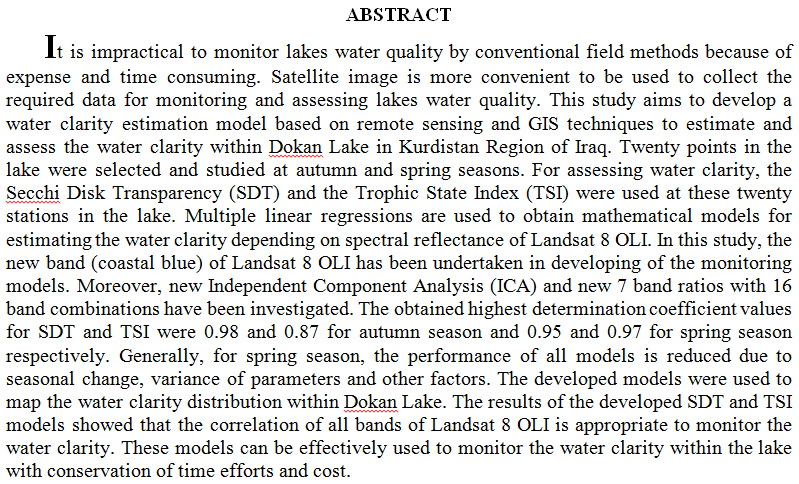
Background: The treatment of dental tissues proceeding to adhesive procedures is a crucial step in the bonding protocol and decides the clinical success ofrestorations. This study was conducted in vitro, with the aim of evaluating thenanoleakage on the interface between the adhesive system and the dentine treated by five surface modalities using scanning electron microscopy and energydispersiveX-ray spectrometry. Materials and methods: Twenty five extracted premolars teeth were selected in the study. Standardized class V cavities were prepared on the buccal and lingual surfaces then the teeth divided into five main groups of (5 teeth in each group n=10) according to the type of dentine surface treatment that was used: Group (A): dentine was
... Show More (2)
(2)
Background: The treatment of dental tissues proceeding to adhesive procedures is a crucial step in the bonding protocol and decides the clinical success ofrestorations. This study was conducted in vitro, with the aim of evaluating thenanoleakage on the interface between the adhesive system and the dentine treated by five surface modalities using scanning electron microscopy and energydispersiveX-ray spectrometry. Materials and methods: Twenty five extracted premolars teeth were selected in the study. Standardized class V cavities were prepared on the buccal and lingual surfaces then the teeth divided into five main groups of (5 teeth in each group n=10) according to the type of dentine surface treatment that was used: Group (A): dentine was
... Show More (2)
(2)
The knowledge related with lexical items can be realized as including relations of meaning a cross words. Words that share a similarity of meaning are called to be synonymous, and words that share a contrary of meaning are called to be antonymous. Both of them are universal linguistic phenomenon that exist in terms of linguistic system of every language. The present study aims at finding out areas of difficulty that Iraqi EFL learners encounter in the use of synonymy and antonymy, both on the recognition and production levels. Also tries to detect the main reasons behind such difficulties. A diagnostic test of two parts, namely, recognition and production, is designed. The test is built to include two linguistic phenomenon which are: synony
... Show More (2)
(2)
This research utilized natural asphalt (NA) deposits from sulfur springs in western Iraq. Laboratory tests were conducted to evaluate the performance of an asphalt mixture incorporating NA and verify its suitability for local pavement applications. To achieve this, a combination of two types of NA, namely soft SNA and hard HNA, was blended to create a binder known as Type HSNA. The resulting HSNA exhibited a penetration grade that adhered to Iraqi specifications. Various percentages of NA (20%, 40%, 60%, and 80%) were added to petroleum asphalt. The findings revealed enhanced physical properties of HSNA, which also satisfied the requirements outlined in the Iraqi specifications for asphalt cement.
Consequently, HS
... Show More (6)
(6)
This research utilized natural asphalt (NA) deposits from sulfur springs in western Iraq. Laboratory tests were conducted to evaluate the performance of an asphalt mixture incorporating NA and verify its suitability for local pavement applications. To achieve this, a combination of two types of NA, namely soft SNA and hard HNA, was blended to create a binder known as Type HSNA. The resulting HSNA exhibited a penetration grade that adhered to Iraqi specifications. Various percentages of NA (20%, 40%, 60%, and 80%) were added to petroleum asphalt. The findings revealed enhanced physical properties of HSNA, which also satisfied the requirements outlined in the Iraqi specifications for asphalt cement. Consequently, HSNA can serve as an
... Show More (6)
(6)
 (11)
(11)
 (2)
(2)
This research examines the phonological adaptation of pure vowels in English loanwords in Iraqi Arabic (IA). Unlike previous small-scale studies, the present study collected 346 loanwords through document review and self-observation, and then analyzed them using quantitative content analysis to identify the patterns of pure vowel adaptation involved in incorporating English loanwords into IA. The content analysis findings showed that most pure vowel adaptations in English loanwords in IA follow systematic patterns and may thus be attributed to specific characteristics of both L1 and L2 phonological systems. Specifically, the findings suggest that the IA output forms typically preserve the features of the input pure vowel to the maxi
... Show MoreThe study was conducted to measure diatom species diversity in the lotic ecosystem across the Wasit Province for 12 months. The quantitative study of diatoms (phytoplankton) was investigated in the Tigris river. The density of algae was ranged from 60989 cell×103/l to 112780.82 cell×103/l in the five sites. These algae were belonging to 39 genera. The richness index values ranged from 1.53 at site 5 in January 2016 to 6.34 at site 1 and June2015. Shannon-Weiner diversity index (H´) was 2.33 in February 2016 and 3.72 in June 2015 both values at site 3, whereas Evenness index was 0.54 at site 5 in March2016 and 0.98 at site 1 in both August2015 and May2016. The lack of homogeneity of the appearance of species indicates the dominance of a
... Show More (23)
(23)
 (8)
(8)
Background: The aims of the study were to evaluate the unclean/clean root canal surface areas with a histopathological cross section view of the root canal and the isthmus and to evaluate the efficiency of instrumentation to the isthmus using different rotary instrumentation techniques. Materials and Methods:The mesial roots of thirty human mandibular molars were divided into six groups, each group was composed of five roots (10 root canals)which prepared and irrigated as: Group one A: Protaper system to size F2 and hypodermic syringe, Group one B: Protaper system to size F2 and endoactivator system, Group two A:Wave One small then primary file and hypodermic syringe, Group two B:Wave One small then primary file and endoactivator system, Gr
... Show More